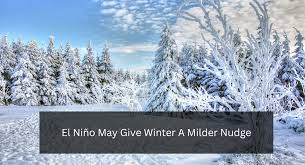Introduction:
As winter settles in, many of us brace ourselves for the chill and unpredictable weather that characterizes the season. However, every so often, a climatic phenomenon known as El Niño comes into play, influencing global weather patterns and potentially giving winter a milder touch. In this blog post, we’ll delve into what El Niño is, how it affects winter weather, and what we can expect when this climate event makes its presence felt.
Understanding El Niño:
El Niño is a complex climate phenomenon that occurs in the equatorial Pacific Ocean. It is characterized by the periodic warming of sea surface temperatures in the central and eastern Pacific, disrupting typical weather patterns around the world. El Niño events typically develop every two to seven years and can last for several months.
How El Niño Impacts Winter Weather:
- Warmer Temperatures: One of the most noticeable effects of El Niño on winter weather is the elevation of temperatures. Warmer-than-average sea surface temperatures in the Pacific can lead to a milder winter in various regions. This warming can influence atmospheric circulation patterns, leading to altered jet stream paths and, subsequently, modified weather conditions.
- Reduced Snowfall: El Niño tends to bring warmer and drier conditions to certain areas, affecting the likelihood of snowfall. Regions that typically experience heavy snowfall during winter may see reduced accumulations or delayed snow events. This can have implications for winter sports enthusiasts, ski resorts, and local economies dependent on snow-related activities.
- Increased Precipitation in Some Areas: While El Niño often brings drier conditions to certain regions, it can result in increased precipitation in others. The altered atmospheric circulation patterns can lead to more rain in some areas, potentially causing flooding or other weather-related challenges.
- Impact on Storm Tracks: El Niño can influence the paths of storms and weather systems. The altered jet stream can redirect storm tracks, affecting where and how precipitation falls. This can lead to shifts in weather patterns, with some areas experiencing more storms while others remain relatively dry.
What to Expect This Winter:
As we head into the winter season, meteorologists closely monitor El Niño conditions to make more accurate predictions about the coming months. While El Niño tends to bring milder temperatures and altered precipitation patterns, it’s essential to remember that its effects can vary from one event to another.
Conclusion:
El Niño’s influence on winter weather highlights the interconnected nature of our planet’s climate systems. As we navigate the uncertainties of the season, staying informed about climate phenomena like El Niño allows us to better understand and prepare for the potential impacts on our local weather. Whether it brings a milder winter or shifts in precipitation patterns, El Niño reminds us that the climate is a dynamic and ever-changing system that plays a crucial role in shaping the weather we experience.



